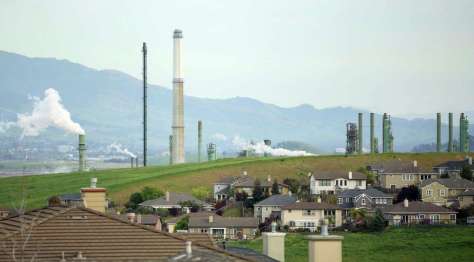-
- No injuries reported from explosion, fire
- Chevron said the fire had been put out
- Blaze could affect jet fuel supply to LAX, southern California
- No evacuations ordered due to fire
Oct 3 (Reuters) – Chevron’s (CVX.N), opens new tab 285,000-barrel-per-day El Segundo refinery in southern California had taken multiple units offline on Friday after a large fire erupted in a jet fuel production unit, disrupting supply in the Golden State’s isolated energy market.
The El Segundo refinery is the second largest in California and Chevron’s second-biggest refinery in the United States. The facility supplies a fifth of all motor vehicle fuels and 40% of the jet fuel consumed in southern California.
The fire at the facility’s jet fuel production unit broke out on Thursday evening. No injuries were reported, and all workers at the refinery were accounted for, Chevron spokesperson Allison Cook said in an email.
Chevron on Friday said the fire had been put out.
It was not immediately clear what caused the explosion at the facility in the suburb of El Segundo, which supplies jet fuel for Los Angeles International Airport (LAX), located just north of the refinery.
“There is no known impact to LAX at this time,” Los Angeles Mayor Karen Bass said.
LAX declined to comment.
The fire broke out in the refinery’s Isomax 7 unit, which converts mid-distillate fuel oil into jet fuel, two sources said.
On Thursday evening, multiple units at the refinery were shut, including the 60,000 barrel per day (bpd) catalytic reformer, 45,000 bpd hydrocracker, and 73,000 bpd fluid catalytic cracker, according to consultancy Wood Mackenzie.
The refinery’s crude distillation units were still online, two traders said, citing Wood Mackenzie data.
AIRLINES HIT MORE THAN DRIVERS
On the West Coast, traders were still assessing the extent of damage to the refinery, but early indications pointed to a small increase in motor fuel prices and potentially larger impacts for aviation fuel.
Gasoline prices in California, already the highest in the country, are expected to rise five to 15 cents per gallon for now as the refinery’s gasoline-producing unit was said to have not been impacted by the fire, said Patrick De Haan, head of petroleum analysis for GasBuddy.
California’s nearly 28 million drivers were paying close to $4.70 a gallon for gasoline in the state as of Friday, compared to a national average of under $3.22 a gallon, GasBuddy data showed.
However, airlines serving southern California will see much bigger impacts, with price for jet fuel surging by 33 cents a gallon Friday afternoon, De Haan said.

California will likely need to pull more jet fuel imports from refiners in South Korea, Taiwan and Japan to make up for the loss of El Segundo’s output, Asian trade sources said.
Southern California’s Long Beach region was receiving around 45,000 to 50,000 bpd of jet fuel imports in recent weeks, and would need to step that up by bringing one more cargo over the next few weeks, a market source said.
Fuel prices in California were expected to surge in the months ahead, as Phillips 66 (PSX.N), opens new tab is winding down operations at its 139,000-bpd Los Angeles-area refinery for permanent closure and Valero’s (VLO.N), opens new tab Benicia refinery is set to close in April 2026. Those two refineries produce roughly 20% of the state’s gasoline supply.
“In a region that was already expected to see some tightness in supplies after a refinery shutdown this December, the fire could provide support to (fuel prices) in the area and a scramble ahead of the closure,” said StoneX analyst Alex Hodes.
FIREBALL TURNED THE SKY ORANGE
Local officials said no evacuation orders were issued for nearby residents, some of whom live in apartment buildings across the street from the refinery.
Residents of Manhattan Beach, located southwest of the refinery, were told to shelter in place until 2 a.m.
“Chevron fire department personnel, including emergency responders from the cities of El Segundo and Manhattan Beach are actively responding to an isolated fire inside the Chevron El Segundo Refinery,” Cook, the Chevron spokesperson, said on Friday.
“All refinery personnel and contractors have been accounted for and there are no injuries,” Cook said.
Los Angeles residents posted numerous videos of the fire online, saying they were stunned by the noise of the blast. A University of California-San Diego camera captured video of the explosion shortly after 9:30 p.m. PDT (0430 GMT).
A fireball from the blaze, along with the refinery’s safety flare – triggered by the fire – turned the sky orange over western Los Angeles, pictures showed.
Safety flares, which emit a tall plume of flame, are used when refineries cannot process hydrocarbons normally.
In addition to Chevron, state and federal safety agencies said they will investigate the fire after the blaze is extinguished.
In December 2022, an isolated fire in the refinery was quickly extinguished. In the U.S. so far in 2025, there have been several refinery fire incidents.
The refinery’s total storage capacity is 12.5 million barrels in about 150 major tanks. The sources said they were not sure how much jet fuel was currently in storage.
Reporting by Nicole Jao and Shariq Khan in New York, Erwin Seba in Houston, Shivani Tanna, Anmol Choubey, Mrinmay Dey in Bengaluru, Stephanie Kelly in London, Trixie Yap in Singapore; Editing by Susan Fenton, Clarence Fernandez, Edward Tobin and Leslie Adler







You must be logged in to post a comment.